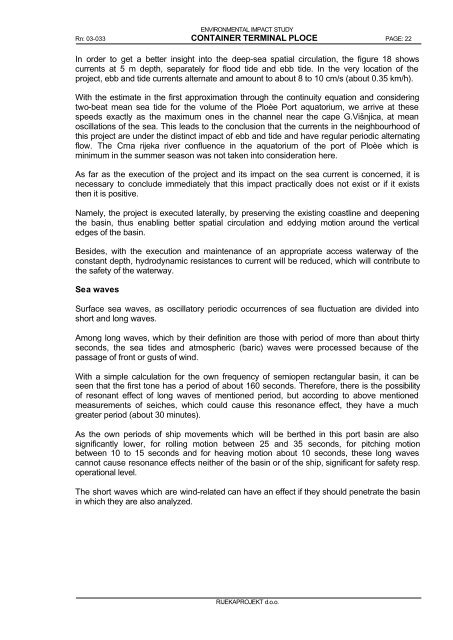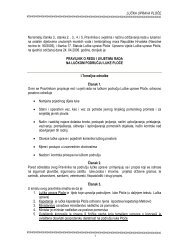HEADING PAGE - port of ploce authority * welcome
HEADING PAGE - port of ploce authority * welcome
HEADING PAGE - port of ploce authority * welcome
You also want an ePaper? Increase the reach of your titles
YUMPU automatically turns print PDFs into web optimized ePapers that Google loves.
ENVIRONMENTAL IMPACT STUDY<br />
Rn: 03-033 CONTAINER TERMINAL PLOCE <strong>PAGE</strong>: 22<br />
In order to get a better insight into the deep-sea spatial circulation, the figure 18 shows<br />
currents at 5 m depth, separately for flood tide and ebb tide. In the very location <strong>of</strong> the<br />
project, ebb and tide currents alternate and amount to about 8 to 10 cm/s (about 0.35 km/h).<br />
With the estimate in the first approximation through the continuity equation and considering<br />
two-beat mean sea tide for the volume <strong>of</strong> the Ploèe Port aquatorium, we arrive at these<br />
speeds exactly as the maximum ones in the channel near the cape G.Višnjica, at mean<br />
oscillations <strong>of</strong> the sea. This leads to the conclusion that the currents in the neighbourhood <strong>of</strong><br />
this project are under the distinct impact <strong>of</strong> ebb and tide and have regular periodic alternating<br />
flow. The Crna rijeka river confluence in the aquatorium <strong>of</strong> the <strong>port</strong> <strong>of</strong> Ploèe which is<br />
minimum in the summer season was not taken into consideration here.<br />
As far as the execution <strong>of</strong> the project and its impact on the sea current is concerned, it is<br />
necessary to conclude immediately that this impact practically does not exist or if it exists<br />
then it is positive.<br />
Namely, the project is executed laterally, by preserving the existing coastline and deepening<br />
the basin, thus enabling better spatial circulation and eddying motion around the vertical<br />
edges <strong>of</strong> the basin.<br />
Besides, with the execution and maintenance <strong>of</strong> an appropriate access waterway <strong>of</strong> the<br />
constant depth, hydrodynamic resistances to current will be reduced, which will contribute to<br />
the safety <strong>of</strong> the waterway.<br />
Sea waves<br />
Surface sea waves, as oscillatory periodic occurrences <strong>of</strong> sea fluctuation are divided into<br />
short and long waves.<br />
Among long waves, which by their definition are those with period <strong>of</strong> more than about thirty<br />
seconds, the sea tides and atmospheric (baric) waves were processed because <strong>of</strong> the<br />
passage <strong>of</strong> front or gusts <strong>of</strong> wind.<br />
With a simple calculation for the own frequency <strong>of</strong> semiopen rectangular basin, it can be<br />
seen that the first tone has a period <strong>of</strong> about 160 seconds. Therefore, there is the possibility<br />
<strong>of</strong> resonant effect <strong>of</strong> long waves <strong>of</strong> mentioned period, but according to above mentioned<br />
measurements <strong>of</strong> seiches, which could cause this resonance effect, they have a much<br />
greater period (about 30 minutes).<br />
As the own periods <strong>of</strong> ship movements which will be berthed in this <strong>port</strong> basin are also<br />
significantly lower, for rolling motion between 25 and 35 seconds, for pitching motion<br />
between 10 to 15 seconds and for heaving motion about 10 seconds, these long waves<br />
cannot cause resonance effects neither <strong>of</strong> the basin or <strong>of</strong> the ship, significant for safety resp.<br />
operational level.<br />
The short waves which are wind-related can have an effect if they should penetrate the basin<br />
in which they are also analyzed.<br />
RIJEKAPROJEKT d.o.o.



